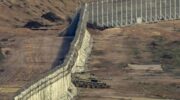Italy’s Mount Etna, one of the world’s most active volcanoes, has blown its top again. The mid-August eruption, the latest in a long line of rumblings from the Sicilian mountain, soon “evolved into a ‘lava fountain'” that produced a “volcanic cloud dispersed in a southerly direction” and forced the temporary closure of a local airport, CNN reported. This comes after Hawaii’s Mauna Loa volcano — the largest active volcano on Earth — awakened from its slumber in 2022, erupting for the first time in nearly 40 years. While these particular eruptions seemed to be contained, other volcanoes around the world could pose even more danger should an explosion occur. Indeed, Nature reported, a massive eruption could have devastating effects “across transport, food, water, trade, energy, finance, and communication in our globally connected world.” Here are six other volcanoes worth fearing:
1. Katla (Iceland)
Last eruption: 1918
Effects of a major eruption: If Katla goes off, its eruption will be 10 times stronger than nearby Eyjafjallajokull, which exploded in 2010, causing billions of dollars in economic damage and leaving millions of travelers stranded. The volcano is known for the “ferocity of its eruptions,” Jónas Elíasson reported in the journal Natural Science in 2014. And while eruptions are common in the volcano-rich Iceland, Katla’s larger ash plume would shoot higher in the air and spread over larger areas of Europe for a longer period, with much more devastating effects on air travel and economic trade. Overall, an eruption would be “a high-hazard and a high-risk event capable of massive property damage and loss of lives,” Elíasson added. As far back as 2014, there were concerns that an eruption could also cause “a tsunami that propagates along the south coast of Iceland and out to sea,” though the effects and potential damage of this are unclear.
Likelihood: Fairly high. The two volcanoes, only 12 miles apart, tend to erupt in tandem, and Katla typically erupts in 40 to 80-year intervals. A 2018 study cited by Iceland Magazine claimed that Katla was “charging up for an eruption,” the outlet summarized.
2. Cumbre Vieja (La Palma, Canary Islands)
Last eruption: 2021
Effects of a major eruption: Cumbre Vieja’s last minor eruption in 2021 resulted in minor damage and a few thousand evacuations. But scientists have previously warned that a major eruption of Cumbre Vieja could cause the entire western flank of the volcano to fall into the sea, creating a “mega-tsunami” wherein “waves hundreds of meters high” would radiate “out into the Atlantic,” the New Zealand Herald reported. However, subsequent studies of “the potential consequences of a collapse at Cumbre Vieja have significantly downplayed the risk” of such an outcome, the Herald added. In a 2021 report for the U.S. Geological Survey, the Hawaiian Volcano Observatory also said that the theory of an eruption-prompted mega-tsunami “does not hold up to rigorous examination.”
Likelihood: Scientists say the “year to year probability” of a major eruption is low, but preparations should be taken anyway given the potentially cataclysmic damages.
3. Cotopaxi (Ecuador)
Last eruption: Ongoing since 2022
Effects of major eruption: Straddling the Andes Mountains, Cotopaxi began roaring back to life in the mid-2010s and has been rumbling on and off consistently since last year. While these eruptions have been mostly minor, a major seismic event “would produce more than 100 million cubic meters of ash — a column at least 12 miles high,” volcanologist Patricia Mothes told The Atlantic in 2017. If this were to occur, it would likely mean that “200,000 people in Cotopaxi’s shadow alone would be directly or moderately affected,” Mothes added. Some estimates have said that a major eruption would be even more devastating — Phys.org reported in 2015 that up to 325,000 people would be immediately at risk if Cotopaxi blew its top, as the volcano’s snowcapped peak would likely melt and cause massive flooding throughout the region.
Likelihood: It’s unclear when Cotopaxi will have its next major eruption. Scientists told The Atlantic it could be months, years or decades — but it will come.
4. Mt. Vesuvius (Italy)
Last eruption: 1944
Effects of major eruption: Famous for wiping out Pompeii and Herculaneum in 79 A.D., Vesuvius would do much greater damage today due to the significantly higher population around the volcano. About 3 million people live close by, according to the CBC’s “The Nature of Things,” many of them in the nearby city of Naples. An additional 600,000 people live near the Vesuvius “red zone,” an area that would have to be evacuated almost immediately in the event of a major eruption. The episode would likely “kill over 10,000 people and cost the Italian economy more than $20 billion,” per “The Nature of Things.” Millions of individuals “would certainly lose power, water and transportation, some for months,” in a scenario that could mirror Iceland’s Eyjafjallajokull eruption in 2010. Beyond this, any eruption “would disrupt air travel and shipping on the entire continent,” and Naples could end up “buried in meters of ash.”
Likelihood: Luckily, scientists say Vesuvius likely won’t have a major eruption again for a few hundred years.
5. Popocatépetl (Mexico)
Last eruption: Ongoing since the early 2000s
Effects of a major eruption: The third-tallest active volcano in the Northern Hemisphere, Popocatépetl is only 40 miles west of Mexico City, whose metropolitan area has an estimated 22 million inhabitants, and just 30 miles east of Puebla, a city of around six million. A large eruption could send “a city-sized cloud of ash 20 centimeters thick” to “descend upon the buildings of Mexico City,” Pacific Standard reported. The deadly cloud would then “clog Mexico City’s drainage lines, poisoning its water supplies and ceasing electricity transmission via short-circuiting,” the outlet added, noting that the devastation would be accompanied by “1,000-degree lahars and pyroclastic flows” that would reach most of the towns in the immediate area.
Likelihood: After an 80-year dormant period, Popocatépetl has had recurring seismic activity for years, with two explosions occurring as recently as September 2022. However, the volcano’s “trends toward relatively small-scale events are quite frequent,” The Wall Street Journal reported, and the last major eruption was more than 1,000 years ago.
6. Yellowstone Supervolcano (Wyoming, United States)
Last eruption: 640,000 years ago
Effects of a major eruption: When the Yellowstone Caldera, or “supervolcano,” in Yellowstone National Park erupts again, “its effects would be worldwide,” the U.S. Geographical Survey said. Most experts believe that a massive eruption “could end up coating a surrounding region 500 miles across in more than four inches of ash,” reported Live Science, which is owned by Future plc, the same parent company as The Week. At the very least, this would result in “the short-term destruction” of Midwest agriculture. But the volcano could also “impact the global climate by emitting ash and gas into the stratosphere, which could block sunlight and lower global temperatures for a few years,” Michael Poland from the Yellowstone Volcano Observatory told Live Science. The resulting catastrophe could “shut down transportation, collapse buildings, short-out the electrical grid and cause massive agricultural failure,” the University of British Columbia’s Johan Gilchrist told CBC Radio.
Likelihood: Geologists see signs that Yellowstone could be preparing for another large blowout soon, though the U.S. Geographical Survey said it is not “overdue” for an eruption, contrary to popular belief.
Skip advert
Updated Aug. 22, 2023: This article has been updated throughout.
Skip advert




